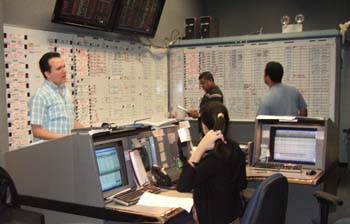A visit to the operations centre gave me an insight into how the canal is run
Yesterday I blogged about going through the Panama Canal (linked here) and about how fascinating I found it.
Today I visited the operations control centre at Balboa.
The photo above shows the canal’s nerve centre. The screens on the back wall are showing all the vessels in the canal at any time, their estimated time of arrival at each checkpoint or lock and their actual time of arrival.
The monitoring is to ensure that as far as possible everyone is compliant with the issued schedule and if not to readjust timings down the line.
The schedule is is devised 24 hours in advance and is based on vessels’ beam, length, draft, pilot requirements, restrictions and need for locomotives while also aiming to get the most number of vessels through the canal each day.
The big screen to the left of the same photo at the top of the page is AIS information from each ship and gives the operations staff real-time data on a vessel’s location, course and speed.

The whiteboards shown in the photo above are pilot assignments. This also shows vessels in transit and their ETAs and actual times, as well as which pilots are aboard and their qualifications. Ships might have one, two or three pilots.
Transit fees, incidentally, can reach US$300,000 for the biggest ships and cruise liners. Yes, you read that right: nearly a third of a million dollars – and that’s minus the agent’s fees.
At the moment, around 37 ships are transiting each day. That’s partly because the Gaillard Cut is a pinch point and there has to be one-way traffic for Panamax vessels and supertankers.
Capacity can be stretched at most to 47 or 48 ships a day. This is achieved by using locomotives in relay in the lock flights, or by using a ‘merry go round’ system with 18 locomotives operating in a loop.
Lock operators can also direct water from the 17ft diameter culverts running down each side of the locks so that two feed into one chamber and fill or empty it in under ten minutes.
I took a photo of one of the locks in construction in the early 1900s that’s displayed in the reception area of the operations centre. It shows how huge the piping systems are.
Unfortunately because of the way our website works this photo can’t be enlarged but I’ve drawn a red ring round the tiny figures of a group of workers at the base of the culvert in the hope they’ll give a sense of scale.





